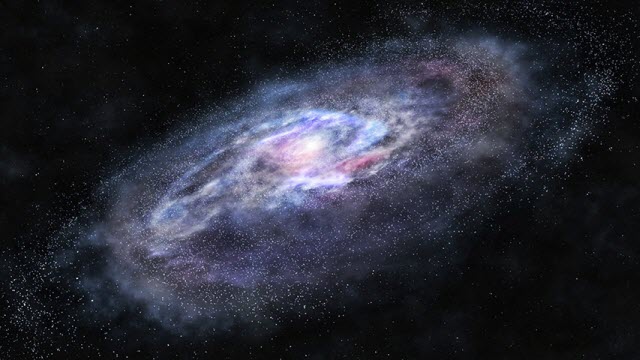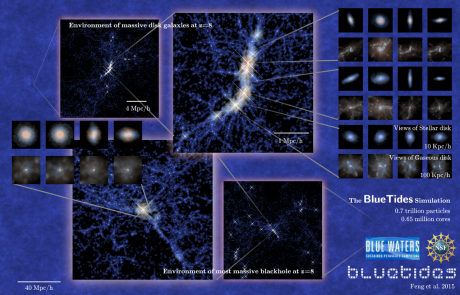 Image courtesy of Carnegie Mellon UniversityA new, large-scale computer simulation has shown for the first time that large disk galaxies, much like our own Milky Way, may have existed in the early days of the universe.
Image courtesy of Carnegie Mellon UniversityA new, large-scale computer simulation has shown for the first time that large disk galaxies, much like our own Milky Way, may have existed in the early days of the universe.
The simulation, created by physicists at Carnegie Mellon University’s McWilliams Center for Cosmology and the University of California Berkeley, shows that the early universe —500 million years after the Big Bang — might have had more order and structure than previously thought.
Their findings, which will be published in The Astrophysical Journal Letters, will help guide researchers using next-generation telescopes like the Wide Field Infrared Survey Telescope (WFIRST) and the James Webb Space Telescope (JWST) as they search the sky for evidence of the first galaxies.
“It’s awe inspiring to think that galaxies much like our own existed when the universe was so young,” said Tiziana Di Matteo, professor of physics at Carnegie Mellon. “The deepest Hubble Space Telescope observations have thus only covered small volumes of space and have found very irregular, clumpy galaxies at these early epochs. It is not surprising that in these small volumes some of the small galaxies do not have regular morphologies like large disk galaxies. Similarly, numerical simulations have been limited in size so they have only made predictions for the smaller, clumpier galaxies at these early times.”
 CMU's current simulation, called BlueTides, is 100 times larger than previous simulations.Image courtesy of Carnegie Mellon UniversityDi Matteo and fellow CMU Physics Professor Rupert Croft have long been at the forefront of simulation cosmology, completing some of the largest simulations ever created. Their current simulation, called BlueTides, is 100 times larger than previous simulations. It was so large that it monopolized all of the National Science Foundation (NSF) supercomputer BlueWater’s memory and almost 1 million CPUs in order to complete the simulation.
CMU's current simulation, called BlueTides, is 100 times larger than previous simulations.Image courtesy of Carnegie Mellon UniversityDi Matteo and fellow CMU Physics Professor Rupert Croft have long been at the forefront of simulation cosmology, completing some of the largest simulations ever created. Their current simulation, called BlueTides, is 100 times larger than previous simulations. It was so large that it monopolized all of the National Science Foundation (NSF) supercomputer BlueWater’s memory and almost 1 million CPUs in order to complete the simulation.
Di Matteo, Croft and their former graduate student Yu Feng, now a post-doctoral researcher at UC Berkeley, began by seeding their simulation with constraints provided by the cold dark matter theory, the prevailing theory that explains what may have happened in the universe after the Big Bang.
After the simulation was completed, the researchers looked at their data to see what they could find, much like observational cosmologists would do with data gathered using a telescope. They were surprised to find a number of disk galaxies in the universe at 500 million years post-Big Bang. Since disk galaxies are so large and complex, most researchers assumed that they would take a very long time to form and would be rare, if they existed at all, in the early universe.
“Theoretically we thought that when the universe was only 5 percent of its present age, it would be a place full of chaos and disorder,” Croft said. “Our simulation showed that the early universe might be far from being just this. It might contain beautiful symmetrical galaxies, like the Milky Way.”
From their simulation, the researchers were able to make predictions about the galaxies’ luminosities, angular sizes, morphologies, colors and expected number. When telescopes like WFIRST and JWST come online, they will be able to search for galaxies that fit the descriptions developed by the BlueTides simulation. If simulation and observational results match, it could be a strong proof of the cold dark matter theory.
“Right now, we’re converging on an exciting time in cosmology. Previously, we couldn’t study disk galaxies in the early universe using telescopes because the galaxies were so faint and rare. We couldn’t study them in a computer because no computers were large enough to cope,” Di Matteo said. “The technology has caught up, and we can complete the simulations using today’s large supercomputers, and we will be able to use telescopes like WFIRST to make the observations.”
This research was funded by the NSF (OCI-0749212, AST-1009781). BlueWaters is located at the National Center for Supercomputing Applications at the University of Illinois.
A new, large-scale computer simulation has shown for the first time that large disk galaxies, much like our own Milky Way, may have existed in the early days of the universe.
The simulation, created by physicists at Carnegie Mellon University’s McWilliams Center for Cosmology and the University of California Berkeley, shows that the early universe —500 million years after the Big Bang — might have had more order and structure than previously thought.
Their findings, which will be published in The Astrophysical Journal Letters, will help guide researchers using next-generation telescopes like the Wide Field Infrared Survey Telescope (WFIRST) and the James Webb Space Telescope (JWST) as they search the sky for evidence of the first galaxies.
To continue reading this article, sign up for FREE to

Membership is FREE and provides you with instant access to eNewsletters, digital publications, article archives, and more.



 Image courtesy of Carnegie Mellon University
Image courtesy of Carnegie Mellon University








